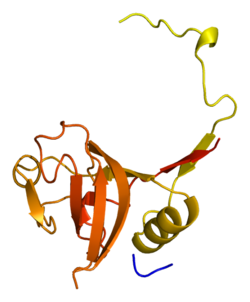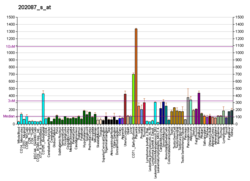组织蛋白酶L1
组织蛋白酶L1(英语:Cathepsin L1)是人类体内由CTSL1基因编码的蛋白质。[3][4][5]该蛋白质是木瓜样蛋白酶,是一种溶酶体半胱氨酸蛋白酶,在细胞内蛋白质分解代谢中起着主要的作用。[6][7][8][9]
作用
[编辑]组织蛋白酶L1是肽酶C1(组织蛋白酶)MEROPS家族的成员。组织蛋白酶L1在包括正常溶酶体介导的蛋白质周转、抗原、前蛋白加工以及细胞凋亡在内的多种过程中发挥重要的作用。[10]其底物包括胶原蛋白、弹性蛋白和SERPINA1,这是中性粒细胞弹性蛋白酶活性的主要控制元素。组织蛋白酶L1与多种病理过程有关,包括肌病、冠状动脉疾病中的肌原纤维坏死以及肾小管对蛋白尿的反应。它是由二硫键连接的重链和轻链组成的二聚体,均由单一蛋白质前体产生。已发现该基因至少有两种编码相同蛋白质的转录变体。[5]
病毒进入
[编辑]病毒进入细胞需要2型新冠病毒S2刺突蛋白的裂解。此过程可以通过位于细胞膜上的蛋白酶——跨膜丝氨酸蛋白酶2或内溶酶体中的组织蛋白酶(主要是组织蛋白酶L1)来完成。[11]羟氯喹可以抑制内溶酶体中组织蛋白酶L1的作用,但由于与跨膜丝氨酸蛋白酶2裂解相比,组织蛋白酶L1的裂解较小,因此羟氯喹对2型新冠病毒感染的抑制作用很小。[11]
炎症
[编辑]虽然组织蛋白酶L1通常被表征为溶酶体蛋白酶,但它可以被分泌,导致病理性炎症。[12]组织蛋白酶L1和其他木瓜样蛋白酶在引起病理性炎症时往往由巨噬细胞和其他侵入组织的免疫细胞分泌而出。[13]
交互作用
[编辑]组织蛋白酶L1已被证明与胱抑素A有相互作用。[14][15]
分布
[编辑]组织蛋白酶L1已在许多生物体中发现,包括鱼类[16]、鸟类、哺乳动物和海绵。[17]
参见
[编辑]参考文献
[编辑]- ^ 1.0 1.1 1.2 GRCh38: Ensembl release 89: ENSG00000135047 - Ensembl, May 2017
- ^ Human PubMed Reference:. National Center for Biotechnology Information, U.S. National Library of Medicine.
- ^ Chauhan SS, Popescu NC, Ray D, Fleischmann R, Gottesman MM, Troen BR. Cloning, genomic organization, and chromosomal localization of human cathepsin L. J Biol Chem. Feb 1993, 268 (2): 1039–45. PMID 8419312. doi:10.1016/S0021-9258(18)54038-2
 .
.
- ^ Joseph LJ, Chang LC, Stamenkovich D, Sukhatme VP. Complete nucleotide and deduced amino acid sequences of human and murine preprocathepsin L. An abundant transcript induced by transformation of fibroblasts. J Clin Invest. Jun 1988, 81 (5): 1621–9. PMC 442598
 . PMID 2835398. doi:10.1172/JCI113497.
. PMID 2835398. doi:10.1172/JCI113497.
- ^ 5.0 5.1 Entrez Gene: CTSL1 cathepsin L1.
- ^ Barrett AJ, Kirschke H. Cathepsin B, Cathepsin H, and cathepsin L. Methods in Enzymology. 1981,. 80 Pt C: 535–561. PMID 7043200. doi:10.1016/s0076-6879(81)80043-2.
- ^ Barrett AJ, Buttle DJ, Mason RW. Lysosomal cysteine proteinases. ISI Atlas of Science. Biochemistry. 1988, 1: 256–260.
- ^ Joseph LJ, Chang LC, Stamenkovich D, Sukhatme VP. Complete nucleotide and deduced amino acid sequences of human and murine preprocathepsin L. An abundant transcript induced by transformation of fibroblasts. The Journal of Clinical Investigation. May 1988, 81 (5): 1621–1629. PMC 442598
 . PMID 2835398. doi:10.1172/JCI113497.
. PMID 2835398. doi:10.1172/JCI113497.
- ^ Kirschke H, Wikstrom P, Shaw E. Active center differences between cathepsins L and B: the S1 binding region. FEBS Letters. February 1988, 228 (1): 128–130. PMID 3342870. doi:10.1016/0014-5793(88)80600-8
 .
.
- ^ Dickinson DP. Cysteine Peptidases of Mammals: Their Biological Roles and Potential Effects in the Oral Cavity and Other Tissues in Health and Disease. Critical Reviews in Oral Biology and Medicine. 2002, 13 (3): 238–75. PMID 12090464. doi:10.1177/154411130201300304.
- ^ 11.0 11.1 Jackson CB, Farzan M, Chen B, Choe H. Mechanisms of SARS-CoV-2 entry into cells. Nature Reviews. Molecular Cell Biology. January 2022, 23 (1): 3–20. PMC 8491763
 . PMID 34611326. doi:10.1038/s41580-021-00418-x.
. PMID 34611326. doi:10.1038/s41580-021-00418-x.
- ^ Gomes CP, Fernandes DE, Casimiro F, da Mata GF, Passos MT, Varela P, et al. Cathepsin L in COVID-19: From Pharmacological Evidences to Genetics. Frontiers in Cellular and Infection Microbiology. 2022, 10: 589505. PMC 7753008
 . PMID 33364201. doi:10.3389/fcimb.2020.589505
. PMID 33364201. doi:10.3389/fcimb.2020.589505  .
.
- ^ Berdowska I, Matusiewicz M. Cathepsin L, transmembrane peptidase/serine subfamily member 2/4, and other host proteases in COVID-19 pathogenesis - with impact on gastrointestinal tract. World Journal of Gastroenterology. October 2021, 27 (39): 6590–6600. PMC 8554394
 . PMID 34754154. doi:10.3748/wjg.v27.i39.6590.
. PMID 34754154. doi:10.3748/wjg.v27.i39.6590.
- ^ Majerle, Andreja; Jerala Roman. Protein inhibitors form complexes with procathepsin L and augment cleavage of the propeptide. Arch. Biochem. Biophys. Sep 2003, 417 (1): 53–8. ISSN 0003-9861. PMID 12921779. doi:10.1016/S0003-9861(03)00319-9.
- ^ Estrada, S; Nycander M; Hill N J; Craven C J; Waltho J P; Björk I. The role of Gly-4 of human cystatin A (stefin A) in the binding of target proteinases. Characterization by kinetic and equilibrium methods of the interactions of cystatin A Gly-4 mutants with papain, cathepsin B, and cathepsin L. Biochemistry. May 1998, 37 (20): 7551–60. ISSN 0006-2960. PMID 9585570. doi:10.1021/bi980026r.
- ^ Venkatesh K, Prasanth B, Rajesh P, Annie JG, Mukesh P, Jesu A. A murrel cysteine protease, cathepsin L: bioinformatics characterization, gene expression and proteolytic activity. Biologia. 2014, 39 (3): 395–406. doi:10.2478/s11756-013-0326-8
 .
.
- ^ Sevenich L, Pennacchio LA, Peters C, Reinheckel T. Human cathepsin L rescues the neurodegeneration and lethality in cathepsin B/L double-deficient mice. Biological Chemistry. July 2006, 387 (7): 885–91 [2022-10-31]. PMID 16913838. S2CID 27739485. doi:10.1515/BC.2006.112. (原始内容存档于2022-10-31).
拓展阅读
[编辑]- Smith CG, Smith MT, Besch NF, et al. Effect of delta 9-tetrahydrocannabinol (THC) on female reproductive function.. Advances in the Biosciences. 1980, 22–23: 449–67. ISBN 9780080237596. PMID 116880. doi:10.1016/b978-0-08-023759-6.50040-8.
- Goretzki L, Schmitt M, Mann K, et al. Effective activation of the proenzyme form of the urokinase-type plasminogen activator (pro-uPA) by the cysteine protease cathepsin L.. FEBS Lett. 1992, 297 (1–2): 112–8. PMID 1551416. S2CID 45421148. doi:10.1016/0014-5793(92)80339-I.
- Dunn AD, Crutchfield HE, Dunn JT. Thyroglobulin processing by thyroidal proteases. Major sites of cleavage by cathepsins B, D, and L.. J. Biol. Chem. 1991, 266 (30): 20198–204. PMID 1939080. doi:10.1016/S0021-9258(18)54909-7
 .
. - Stearns NA, Dong JM, Pan JX, et al. Comparison of cathepsin L synthesized by normal and transformed cells at the gene, message, protein, and oligosaccharide levels.. Arch. Biochem. Biophys. 1991, 283 (2): 447–57. PMID 2275556. doi:10.1016/0003-9861(90)90666-M.
- Ritonja A, Popović T, Kotnik M, et al. Amino acid sequences of the human kidney cathepsins H and L.. FEBS Lett. 1988, 228 (2): 341–5. PMID 3342889. S2CID 45768546. doi:10.1016/0014-5793(88)80028-0
 .
. - Gal S, Gottesman MM. Isolation and sequence of a cDNA for human pro-(cathepsin L).. Biochem. J. 1988, 253 (1): 303–6. PMC 1149292
 . PMID 3421948. doi:10.1042/bj2530303.
. PMID 3421948. doi:10.1042/bj2530303. - Johnson DA, Barrett AJ, Mason RW. Cathepsin L inactivates alpha 1-proteinase inhibitor by cleavage in the reactive site region.. J. Biol. Chem. 1986, 261 (31): 14748–51. PMID 3490478. doi:10.1016/S0021-9258(18)66935-2
 .
. - Mason RW, Walker JE, Northrop FD. The N-terminal amino acid sequences of the heavy and light chains of human cathepsin L. Relationship to a cDNA clone for a major cysteine proteinase from a mouse macrophage cell line.. Biochem. J. 1987, 240 (2): 373–7. PMC 1147428
 . PMID 3545185. doi:10.1042/bj2400373.
. PMID 3545185. doi:10.1042/bj2400373. - Joseph L, Lapid S, Sukhatme V. The major ras induced protein in NIH3T3 cells is cathepsin L.. Nucleic Acids Res. 1987, 15 (7): 3186. PMC 340927
 . PMID 3550705. doi:10.1093/nar/15.7.3186.
. PMID 3550705. doi:10.1093/nar/15.7.3186. - Kärgel HJ, Dettmer R, Etzold G, et al. Action of rat liver cathepsin L on glucagon.. Acta Biol. Med. Ger. 1982, 40 (9): 1139–43. PMID 7340337.
- Bevec T, Stoka V, Pungercic G, et al. Major histocompatibility complex class II-associated p41 invariant chain fragment is a strong inhibitor of lysosomal cathepsin L.. J. Exp. Med. 1996, 183 (4): 1331–8. PMC 2192513
 . PMID 8666891. doi:10.1084/jem.183.4.1331.
. PMID 8666891. doi:10.1084/jem.183.4.1331. - Coulombe R, Grochulski P, Sivaraman J, et al. Structure of human procathepsin L reveals the molecular basis of inhibition by the prosegment.. EMBO J. 1996, 15 (20): 5492–503. PMC 452294
 . PMID 8896443. doi:10.1002/j.1460-2075.1996.tb00934.x.
. PMID 8896443. doi:10.1002/j.1460-2075.1996.tb00934.x. - Baumgrass R, Williamson MK, Price PA. Identification of peptide fragments generated by digestion of bovine and human osteocalcin with the lysosomal proteinases cathepsin B, D, L, H, and S.. J. Bone Miner. Res. 1997, 12 (3): 447–55. PMID 9076588. S2CID 20815411. doi:10.1359/jbmr.1997.12.3.447
 .
. - Fujishima A, Imai Y, Nomura T, et al. The crystal structure of human cathepsin L complexed with E-64.. FEBS Lett. 1997, 407 (1): 47–50. PMID 9141479. S2CID 46288832. doi:10.1016/S0014-5793(97)00216-0
 .
. - Ménard R, Carmona E, Takebe S, et al. Autocatalytic processing of recombinant human procathepsin L. Contribution of both intermolecular and unimolecular events in the processing of procathepsin L in vitro.. J. Biol. Chem. 1998, 273 (8): 4478–84. PMID 9468501. doi:10.1074/jbc.273.8.4478
 .
. - Schick C, Pemberton PA, Shi GP, et al. Cross-class inhibition of the cysteine proteinases cathepsins K, L, and S by the serpin squamous cell carcinoma antigen 1: a kinetic analysis.. Biochemistry. 1998, 37 (15): 5258–66. PMID 9548757. doi:10.1021/bi972521d.
- Estrada S, Nycander M, Hill NJ, et al. The role of Gly-4 of human cystatin A (stefin A) in the binding of target proteinases. Characterization by kinetic and equilibrium methods of the interactions of cystatin A Gly-4 mutants with papain, cathepsin B, and cathepsin L.. Biochemistry. 1998, 37 (20): 7551–60. PMID 9585570. doi:10.1021/bi980026r.
- Halfon S, Ford J, Foster J, et al. Leukocystatin, a new Class II cystatin expressed selectively by hematopoietic cells.. J. Biol. Chem. 1998, 273 (26): 16400–8. PMID 9632704. doi:10.1074/jbc.273.26.16400
 .
.
外部链接
[编辑]- The MEROPS online database for peptidases and their inhibitors: C01.032[失效連結]
- 醫學主題詞表(MeSH):Cathepsin+L



